
Principles and Applications of Asymmetric Synthesis
.pdf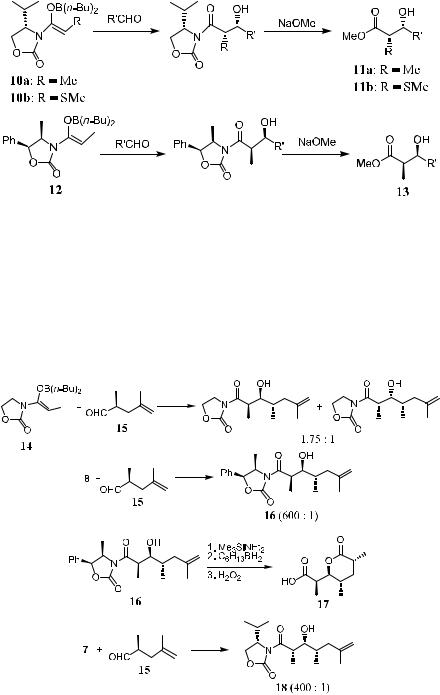
140 ALDOL AND RELATED REACTIONS
Scheme 3±5
selectivity. A diastereofacial ratio of 600:1 for the matched pair was obtained. Compound 16 can be easily transformed to the Prelog-Djerrassi lactone 17 via standard well-established procedures. Even in the case of a mismatched pair, for example, treatment of aldehyde 15 with another Evans' auxiliary 7, which exerts the opposite function in terms of stereoselectivity in comparison with 8, product 18 can still be obtained with highly satisfactory diastereoselectivity (400:1) (Scheme 3±6).10
Scheme 3±6
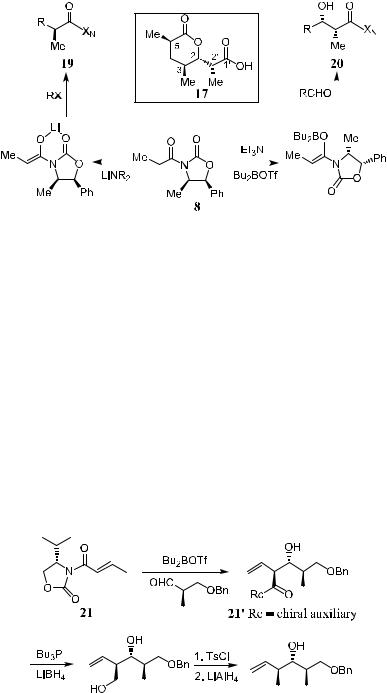
3.2 SUBSTRATE-CONTROLLED ALDOL REACTION |
141 |
||||||||||||
|
|
|
|
|
|
|
|
|
|
|
|
|
|
|
|
|
|
|
|
|
|
|
|
|
|
|
|
|
|
|
|
|
|
|
|
|
|
|
|
|
|
|
|
|
|
|
|
|
|
|
|
|
|
|
|
|
|
|
|
|
|
|
|
|
|
|
|
|
|
|
|
|
|
|
|
|
|
|
|
|
|
|
|
|
|
|
|
|
|
|
|
|
|
|
|
|
|
|
|
|
|
|
|
|
|
|
|
|
|
|
|
Scheme 3±7. XN ˆ chiral auxiliary.
Compound 17 is the so-called (‡)-Prelog-Djerassi lactonic acid derived via the degradation of either methymycin or narbomycin. This compound embodies important architectural features common to a series of macrolide antibiotics and has served as a focal point for the development of a variety of new stereoselective syntheses. Another preparation of compound 17 is shown in Scheme 3±7.11 Starting from 8, by treating the boron enolate with an aldehyde, 20 can be synthesized via an asymmetric aldol reaction with the expected stereochemistry at C-2 and C-20. Treating the lithium enolate of 8 with an electrophile a¨ords 19 with the expected stereochemistry at C-5. Note that the stereochemistries in the aldol reaction and in a-alkylation are opposite each other. The combination of 19 and 20 gives the ®nal product 17.
Compound a-vinyl-b-hydroxyimdide 210, which can be used in the total synthesis of natural products, can be prepared through aldol reaction. In most cases of aldol reactions mediated by 21, products of more than 98% de can be obtained (Scheme 3±8).12
Scheme 3±8
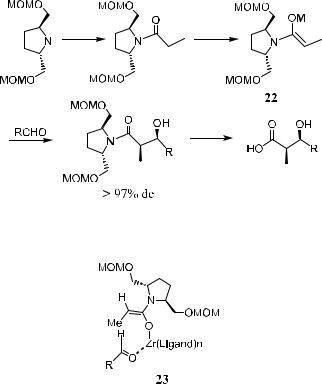
142 ALDOL AND RELATED REACTIONS
3.2.2Pyrrolidines as Chiral Auxiliaries
The frequent occurrence of b-hydroxy carbonyl moiety in a variety of natural products (such as macrolide or ionophore antibiotics or other acetogenics) has stimulated the development of stereocontrolled synthetic methods for these compounds. Indeed, the most successful methods have involved aldol reactions.13
Amide enolate 22 bearing a trans-2,5-disubstituted pyrrolidine moiety as the amine component has proved to be an excellent substrate in asymmetric alkylation14 and acylation15 reactions. In contrast to these successes, using its lithium enolate in an aldol reaction fails to give good stereoselectivity (entry 1 in Table 3±2). On the other hand, zirconium enolate16 prepared from the corresponding lithium enolate and bis(cyclopentadienyl)zirconium dichloride exhibits a remarkably high stereoselectivity (entries 2±5 in Table 3±2).
Studies show that the Zr-bearing bulky ligand is exclusively located in the bottom hemisphere with respect to the plane of the (Z)-enolate. The aldehyde molecule coordinates with the Zr atom and approaches from the same side, adopting a chair-like transition state. This leads to the formation of erythroaldols (Scheme 3±9 and 23). For lithium enolate, the attack of alkyl or acyl halides in alkylation or acylation occurs directly on the top face of the enolate.
Scheme 3±9

TABLE 3±2. Aldol Reaction of Propionamide Enolate with Aldehydes
|
|
|
Ratio of diastereomers in product |
|
|
|||
Entry |
R in RCHO |
Metal |
|
|
|
|
|
Yield (%) |
erythro |
erythro |
|
threo |
threo |
||||
|
|
|
|
|
|
|
|
|
1 |
C6H5 |
Li |
30 |
50 |
<1 |
|
20 |
82 |
|
|
|
…2S ; 5R ; 20R ; 30R † |
|
…2S ; 5R ; 20S ; 30R † |
|
|
|
2 |
C6H5 |
Zr |
60 |
1 |
<1 (other two isomers) |
|
88 |
|
|
|
|
…2S ; 5S ; 20R ; 30R † |
|
|
|
|
|
3 |
(CH3)2CH |
Zr |
100 |
|
<1 |
(other three isomers) |
|
85 |
|
|
|
…2S ; 5S ; 20R ; 30S † |
|
|
|
|
|
4 |
CH3CH2 |
Zr |
100 |
|
<1 |
(other three isomers) |
|
92 |
|
|
|
…2S ; 5S ; 20R ; 30S † |
|
|
|
|
|
5 |
CH3CHbCH |
Zr |
100 |
1 |
<1 |
(other two isomers) |
|
98 |
|
|
|
…2S ; 5S ; 20R ; 30R † |
|
|
|
|
|
143
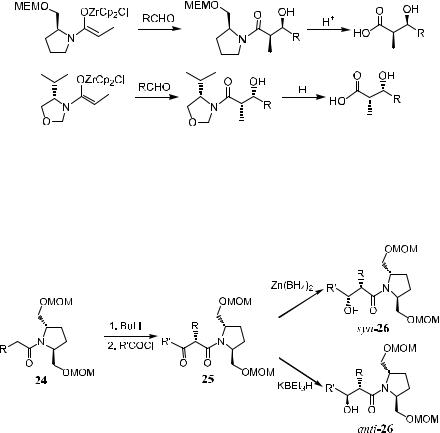
144 ALDOL AND RELATED REACTIONS
The importance of the sterically demanding metal centers in aldol regulations is thus apparent.
The stereochemical assignment of the condensation products reveals that asymmetric induction in this reaction is opposite to that observed in the previously discussed alkylation or acylation.
As with the above pyrrolidine, proline-type chiral auxiliaries also show different behaviors toward zirconium or lithium enolate±mediated aldol reactions. Evans found that lithium enolates derived from prolinol amides exhibit excellent diastereofacial selectivities in alkylation reactions (see Section 2.2.3.2), while the lithium enolates of proline amides are unsuccessful in aldol condensations. E¨ective chiral reagents were zirconium enolates, which can be obtained from the corresponding lithium enolates via metal exchange with Cp2ZrCl2. For example, excellent levels of asymmetric induction in the aldol process with syn/ anti selectivity of 96±98% and diastereofacial selectivity of 50±200:116a can be achieved in the Zr-enolate±mediated aldol reaction (see Scheme 3±10).
Scheme 3±10. MEM ˆ methoxyethoxymethyl; Cp ˆ cyclopentadienyl.
Acylated product 25 can be obtained by reacting the enolate of 24 with acyl chloride. Interestingly, synor anti-26 can be obtained upon treating the acylated enolate 25 with Zn(BH4)2 and KBEt3H, respectively (Scheme 3±11 and
Scheme 3±11

3.2 SUBSTRATE-CONTROLLED ALDOL REACTION |
145 |
TABLE 3±3. Asymmetric Acylation Using (2S,5S )-24 and Subsequent Stereoselective Reduction with Zinc Borohydride in THF at ÿ78 C
|
|
|
Acylation Product 25 |
|
Reduction Product 26 |
||
|
R0 |
|
|
|
|
|
|
Entry |
R |
Yield (%) |
de (%) |
|
Yield (%) |
syn:anti |
|
|
|
|
|
|
|
|
|
1 |
C2H5 |
CH3 |
74 |
98 |
96 |
99:1 |
|
2 |
(CH3)2CH |
CH3 |
95 |
98 |
99 |
>99:1 |
|
3 |
(CH3)3C |
CH3 |
80 |
98 |
99 |
96:4 |
|
4 |
C9H15 |
CH3 |
90 |
98 |
98 |
>97:3 |
|
5 |
Ph |
CH3 |
90 |
98 |
93 |
>99:1 |
|
6 |
PhCH2 |
CH3 |
76 |
98 |
98 |
99:1 |
|
7 |
(CH3)2CH |
PhCH2 |
96 |
98 |
98 |
99:1 |
|
8 |
CH3CHbCH |
CH3 |
47 |
98 |
97 |
97:3 |
|
9 |
PhCHbCH |
CH3 |
61 |
98 |
95 |
>99:1 |
|
de ˆ Diastereomeric excess.
Table 3±3). Although the initial step is an a-acylation reaction, the ®nal resultant compound can still be considered an aldol reaction product.
3.2.3Aminoalcohols as the Chiral Auxiliaries
The aldol reactions introduced thus far have been performed under basic conditions where enolate species are involved as the reactive intermediate. In contrast to the commonly accepted carbon-anion chemistry, Mukaiyama developed another practical method in which enol species can be used as the key intermediates. He is the ®rst chemist to successfully demonstrate that acid-catalyzed aldol reactions using Lewis acid (such as TiCl4) and silyl enol ether as a stable enol equivalent can work as well.17 Furthermore, he developed the boron tri- ¯uoromethane sulfonate (tri¯ate)±mediated aldol reactions via the formation of formyl enol ethers.
(Silyloxy)alkenes were ®rst reported by Mukaiyama as the requisite latent enolate equivalent to react with aldehydes in the presence of Lewis acid activators. This process is now referred to as the Mukaiyama aldol reaction (Scheme 3±12). In the presence of Lewis acid, anti-aldol condensation products can be obtained in most cases via the reaction of aldehydes and silyl ketene acetals generated from propionates under kinetic control.
Another chiral auxiliary for controlling the absolute stereochemistry in Mukaiyama aldol reactions of chiral silyl ketene acetals has been derived from N-methyl ephedrine.18 This has been successfully applied to the enantioselective synthesis of various natural products19 such as a-methyl-b-hydroxy esters (ee 91±94%),18,20 a-methyl-b-hydroxy aldehydes (91% ee),21 a-hydrazino and a-amino acids (78±91% ee),22 a-methyl-d-oxoesters (72±75% ee),20b cisand trans-b-lactams (70±96% ee),23 and carbapenem antibiotics.24
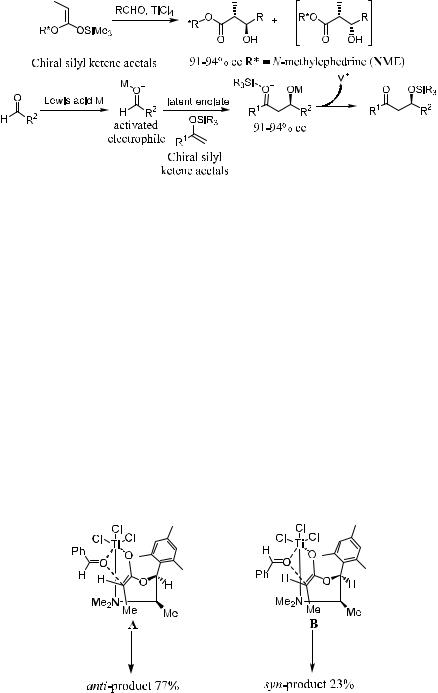
146 ALDOL AND RELATED REACTIONS
Scheme 3±12. Mukaiyama aldol reactions.
With chiral enol species (E )-silylketene acetal derived from (1R,2S)-N- methyl ephedrine-O-propionate, both the aldehyde carbonyl and the ephedrine NMe2 group are expected to bind to TiCl4, which usually chelates two electrondonating molecules to form cis-octahedral six-coordinated complexes.25 Conformational freedom is therefore reduced, and the C±C bond formation occurs on the six-coordinated metal in a highly stereoselective manner.18
As shown in Figure 3±2, titanium is coordinated with the oxygen from both the aldehyde and the alkene enol silyl ether. When aldehyde approaches the enol species, intermediate A is favored to B, and anti-aldol is obtained as the major product. Table 3±4 presents some results of these reactions.
Ligands for catalytic Mukaiyama aldol addition have primarily included bidentate chelates derived from optically active diols,26 diamines,27 amino acid derivatives,28 and tartrates.29 Enantioselective reactions induced by chiral Ti(IV) complex have proved to be one of the most powerful stereoselective transformations for synthetic chemists. The catalytic asymmetric aldol reaction introduced by Mukaiyama is discussed in Section 3.4.1.
Catalyst 29,30 obtained by treating 28 with Ti(OPri)4, does not give a good
Figure 3±2. Ephedrine auxiliary in mukaiyama reaction.
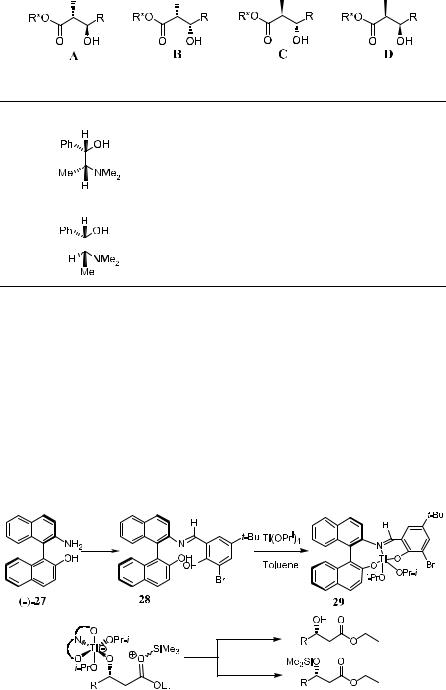
3.2 SUBSTRATE-CONTROLLED ALDOL REACTION |
147 |
|||||||||
|
|
|
|
|
|
|
|
|
|
|
|
|
|
|
|
|
|
|
|
|
|
|
|
|
|
|
|
|
|
|
|
|
|
|
|
|
|
|
|
|
|
|
|
TABLE 3±4. Reaction of Silyl Ketene Acetals with Aldehydes
Entry |
R OH |
RCHO |
anti/syn(A |
‡ |
C )/(B |
‡ |
D) |
A/C |
|
|
|||||||
1 |
|
PhCHO |
85:15 |
|
|
97:3 |
||
2 |
" |
n-C3H7CHO |
80:20 |
95.5:4.5 |
|
3 |
|
|
PhCHO |
77:23 |
93:7 |
|
|
||||
Reprinted with permission by Am. Chem. Soc., Ref. 18.
result. Both the yield and ee are low. This can be explained by reference to Figure 3±3, which indicates the nonspeci®c transfer of the TMS group to either the isopropoxide or the aldolate in the following transition state.
As indicated in Scheme 3±13, replacing the isopropoxide counterions with less basic oxyanions, namely, commercially available 3,5-di-tert-butylsalicylic acid, will lead to new catalyst 30, which shows very good results for the asymmetric aldol addition of alkyl acetate to ketene acetals (Scheme 3±13).
This catalyst is readily soluble in ether, and the aldol reaction proceeds with high yield (>95% in most cases) and enantioselectivity (>90% in most cases) in the presence of a catalytic amount of 30. The salicylate counterion probably
Figure 3±3. Poor result in 29 mediated aldol reaction.
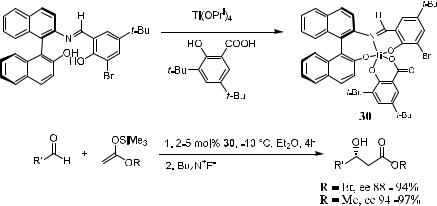
148 ALDOL AND RELATED REACTIONS
Scheme 3±13
serves as a shuttle for the TMS group between the catalyst and the silylated aldol product, thereby facilitating the regeneration of the catalyst.
3.2.4Acylsultam Systems as the Chiral Auxiliaries
Besides their application in asymmetric alkylation, sultams can also be used as good chiral auxiliaries for asymmetric aldol reactions, and anti-product can be obtained with good selectivity. As can be seen in Scheme 3±14, reaction of the propionates derived from chiral auxiliary R -OH with LICA in THF a¨ords the lithium enolates. Subsequent reaction with TBSCl furnishes the O-silyl ketene acetals 31, 33, and 35 with good yields.31 Upon reaction with TiCl4 complexes of an aldehyde, product b-hydroxy carboxylates 32, 34, and 36 are obtained with high diastereoselectivity and good yield. Products from direct aldol reaction of the lithium enolate without conversion to the corresponding silyl ethers show no stereoselectivity.32
In Scheme 3±15, boryl enolates can be obtained by treating N-propionyl- sultam with Et2BOTf and i-Pr2NEt. No reaction is observed in the presence of SnCl4 or BF3 OEt2. However, in the presence of TiCl4, the aldol reaction proceeds smoothly, yielding anti-product with good stereoselectivity. Stereoselectivity decreased slightly when the amount of TiCl4 was lowered. The optimized procedure involves the addition of a mixture of aldehyde/TiCl4 in CH2Cl2 to a stirred solution of boryl enolate prepared in situ at ÿ78 C, stirring at ÿ78 C for 0.5 to 4 hours, and aqueous workup.33
In summary, boryl enolate 38 can be obtained via in situ O-borylation of N- propionylsultam 37 and converted to aldol product 40 upon treatment with aliphatic, aromatic, or a,b-unsaturated aldehdyes at ÿ78 C in the presence of TiCl4. As aldol product 40 can normally be obtained in crystalline form, in most cases diastereomerically pure anti-aldol 40 can also be obtained after the recrystallization.
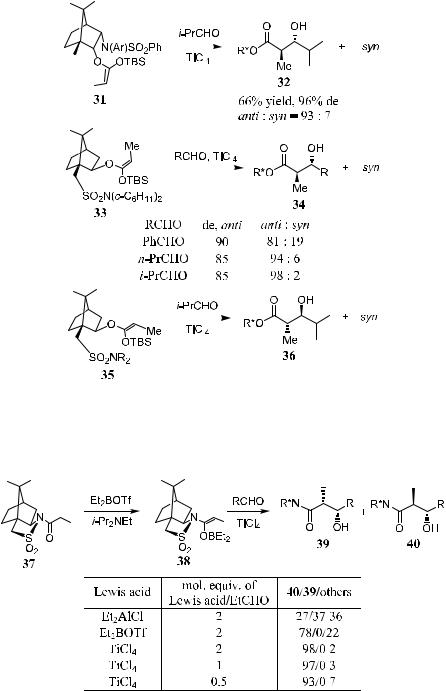
3.2 SUBSTRATE-CONTROLLED ALDOL REACTION |
149 |
|||||||||||||||
|
|
|
|
|
|
|
|
|
|
|
|
|
|
|
|
|
|
|
|
|
|
|
|
|
|
|
|
|
|
|
|
|
|
|
|
|
|
|
|
|
|
|
|
|
|
|
|
|
|
|
|
|
|
|
|
|
|
|
|
|
|
|
|
|
|
|
|
|
|
|
|
|
|
|
|
|
|
|
|
|
|
|
|
|
|
|
|
|
|
|
|
|
|
|
|
|
|
|
|
|
|
|
|
|
|
|
|
|
|
|
|
|
|
|
|
|
|
|
|
|
|
|
|
|
|
|
|
|
|
|
|
|
|
|
|
|
|
|
|
|
|
|
|
|
|
|
|
|
|
|
|
|
|
|
|
|
|
|
|
|
|
|
|
|
|
|
|
|
|
|
|
|
|
|
|
|
|
|
|
|
|
|
|
|
|
|
|
|
|
|
|
|
|
|
|
|
|
|
|
|
|
|
|
|
|
|
|
|
|
|
|
|
|
|
|
|
|
|
|
|
|
|
|
|
|
|
|
|
|
|
|
|
|
|
|
|
|
Scheme 3±14
Scheme 3±15. Reprinted with permission by Pergamon Science Ltd., Ref. 33.
